Invicta Flies - West Branch Caddis
Credited to Eddie Reif of Bangor, Maine, the West Branch Caddis (named for the prolific caddis hatches of the West Branch of the Penobscot River) is an effective caddis emerger imitation, whether fished dead drift in the film, or "on the swing" when sunk. The original calls for drake mallard breast for the wing, but others can be used for a variety of colors and markings. Another version, Nancy's Prayer (named for Nancy Pray of Pray's Campground on the Big Eddy pool of the West Branch) uses Drake wood duck for the wing.
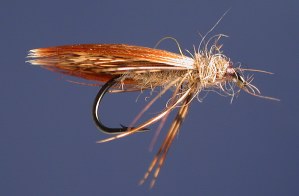
Tied by Bob Erickson
Thanks to Bob Erickson of Huntington, Vermont for sharing this pattern with us. Bob also tied all the flies featured on this page. See below for Bob's versions using hen mallard and black duck for the wing. Additionally, you can add Z-lon for trailing shucks, wood duck flank fibers for antennae, or a turn or two of hen hackle for legs.
Hook: TMC 102Y, #17 (shown here) or other dry fly hook
Thread: 6/0, color to match body
Abdomen: dubbing to match natural
Wing: breast feather from mallard drake or hen, wood duck, or others to match locals
Thorax: same as abdomen
Legs (optional): fibers pulled down from wing, or hackle
Tying Instructions:
1) Secure the thread above the hook point and wind back to the bend. If you opt for a trailing shuck, tie in just a wisp of Z-Lon or Antron fibers about as long as the hook shank.
2) Dub the abdomen with a color dubbing that matches the prevalent caddis in your area. Don't make the body too tight... a slightly "shaggy" appearance gives the illusion of the emerging caddis. Dub up to about 1/3 the shank behind the eye.
3) Select a breast feather with markings that closely resemble the locals. Bob suggests using two or even three feathers of the same size to help hold the wing's shape and envelope the body. A partridge feather can also be used for the underwing, and this also creates nice legs on the pattern if you choose to have them (see notes below). Even up the feathers and lash them to the top of the shank with a couple fairly loose turns of thread. Pull down gently to tighten, holding the wing as necessary to keep it on top. For position, we want the length about a hook gap past the bend, and at the tie-in point, the wing should "fold over" the top half of the body (see photos for reference). Take a couple more tight turns of thread to secure and clip any excess of the feathers that reach the hook eye.
4) If adding hackle for legs, tie this feather in at this point. Keep the wraps somewhat sparse, and a soft hackle can even be used to suggest movement (this pattern is meant for sitting in the surface film).
5) Dub a thorax with the same dubbing used for the abdomen up to about a hook eye's width behind the eye. This should be slightly larger in diameter than the rest of the body. Palmer the hackle forward if used, then build a small rounded head. Whip finish the thread, clip, and cement.
Notes: To use the underwing fibers as legs, stroke three fibers back on each side to seperate them from the rest of the wing before tying them in. Now tie the wing in as usual, with the six fibers protruding over the hook eye (or out to the sides). Dub a hook-eye's width of the thorax, then pull the six fibers down and lash into place with a couple turns of thread, positioning them on the bottom. Finish dubbing the thorax. For antennae, two wood duck flank fibers or similar can be tied in facing forward over the hook eye before the thorax is dubbed, or pointing to the rear before completing the head.
Variations tied by Bob Erickson:
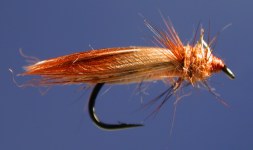 "Nancy's Prayer" (wood duck wing) with hackle added.
|
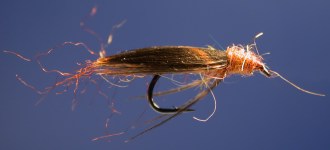 |
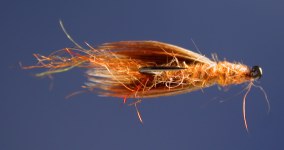 Nancy's Prayer with trailing shuck.
|
 Hen mallard wing.
|
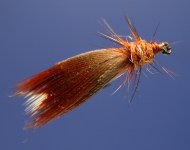 |
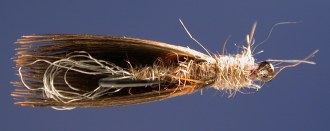 Black duck wing, Z-Lon loop trailing shuck.
|